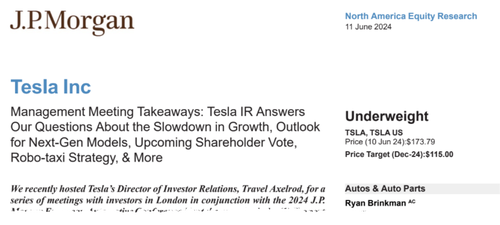


Elon Musk has said that a purpose-built robotaxi will be the centerpiece of his long-term strategy for Tesla.
In about two months, on August 8, Musk is set to unveil the 'Robotaxi,' potentially positioning Tesla to compete with some of the largest ride-hailing services. However, before these robotaxis flood city streets and highways, Tesla must first solve full autonomous driving mode.
Tesla has yet to announce a timeline for the Robotaxi or Full Self-Driving (FSD) with no intervention.
Musk recently said that future FSD versions are getting so accurate that "it is starting to get to the point where, once known bugs are fixed, it will take over a year of driving to get even one intervention."
Tesla's latest FSD version (Full Self-Driving v12.4.1) has become more refined ahead of the robotaxi unveiling event.
At the recent JPMorgan European Automotive Conference in London, analysts from the bank, led by Ryan Brinkman, wrote in a note on Tuesday about a conversation with Tesla's Director of Investor Relations, Travis Axelrod.
Brinkman provided clients with a seven-point bullet list highlighting the most critical topics discussed:
The next wave of the company's growth will be led by the introduction of lower cost models expected in force by 2025 which utilize existing platforms and assembly lines rather than the earlier planned next-generation platform, suggesting the potential for less near-term reduction in COGS but also significant capital savings;
Augmenting the re-acceleration of unit volume growth next year is expected to be continued strong growth in energy storage and services, and autonomy becoming a more meaningful contributor;
Nothing has changed with regards to the company's ambitious long-term volume targets;
Ratification of CEO Elon Musk's 2018 compensation plan at a shareholder meeting later this week was said in our meetings to be important in allowing the company to refocus on operational goals by putting the corporate governance issue behind it and because it would allow Mr. Musk to remain comfortable pursuing "real world AI" opportunities within Tesla;
Mr. Musk's creation of a separate vehicle (xAI) to pursue more generalized or language model artificial intelligence opportunities outside of Tesla was said to not conflict with the automaker's more robotics focused AI efforts;
Management continues to believe in the superiority of its vision-only based approach to Full Self-Driving, believing it to be by far the lowest cost and most scalable way forward;
Because Tesla expects varying degrees of interest on the part of customers when it comes to placing their private vehicles on a public robo- taxi network, it expects to augment this supply with a dedicated robo-taxi vehicle which will offer cost and utility advantages relative to a traditional consumer vehicle (the expected basing of this dedicated robo-taxi on Tesla's delayed next- generation platform in our view implies timing could be some years away).
Brinkman provides highlights from the conversation on robotaxi. The biggest takeaway is that the analyst doesn't believe there will be material revenue generation from these taxis "for years to come."
Here's the biggest takeaway from the robotaxi conversation:
Robotaxis have the potential to be a major revenue driver for Tesla. However, as previously noted, fully solving FSD is a prerequisite before these taxis can hit the road.

